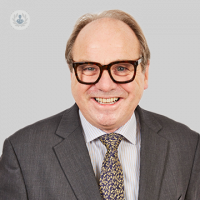Fatty liver disease: how can I reduce my fatty liver?
Written by:It is normal to have a small level of fat in your liver. Fatty liver disease occurs when more than 5% of the liver is occupied by fat. Fatty liver disease affects 20% or 1 in 5 of the adult population in the UK. Here, one of our top hepatologists Professor Kevin Moore explains the causes of fatty liver disease, why it is important to diagnose the condition and how it can be reduced.

What is the role of the liver in the body?
The liver is the metabolic and toxin clearing powerhouse of the body. Everything that you eat or drink is absorbed through the intestines, and the blood that supplies the intestines has to pass through the liver before being circulated to the rest of the body.
In the liver, toxic substances are detoxified, drugs are metabolised and important foods, such as sugar and fats, are handled in a way to enable the efficient storage of energy throughout the body. The liver also has an important role in producing most of the proteins including clotting factors that circulate in the bloodstream.
What are the causes of fatty liver?
The commonest causes of fatty liver include:
- Being overweight or obese
- Type 2 diabetes mellitus
- Alcohol
- Lack of physical activity
- Metabolic syndrome – mild hyperglycaemia, hyperlipidaemia, mild diabetes, and increased waist circumference.
Metabolic syndrome is more common in Asian subjects. Fatty liver is also sometimes called NAFLD or non-alcoholic fatty liver disease. In this group, alcohol is excluded, but I have included alcohol as an important cause of fatty liver since all of the alcohol you drink is metabolised into fat, and the distinction between non-alcoholic and alcoholic fatty liver is only useful to identify alcohol as a major risk factor, and for clinical trial purposes.
Why is it important to diagnose, assess and treaty fatty liver disease?
In the majority (85%) of patients, the fat in the liver simply sits there. This is often termed simple steatosis because it is not causing any inflammation.
However, in 15% (1 in 6) of patients with fatty liver, the fat in the liver causes low-grade inflammation. We don’t know why this happens in some people and not others, and there are no simple blood tests to see if your liver has low-grade inflammation (called non-steatohepatitis or non-alcoholic steatohepatitis or NASH, when alcohol has been excluded). It is my view that some patients experience slight discomfort or awareness of the liver, but whether this correlates with low-grade inflammation is unknown.
It is this small group of patients with NASH who are at risk of developing significant scarring (fibrosis) or cirrhosis of the liver and liver cancer. Thus we can estimate that 1% of the adult population have cirrhosis due to the presence of fatty liver disease.
I like to use the following analogy on the importance of fat in the liver. Imagine pricking your thumb with a pin once a day every day of the year. After four weeks you have 28 pinpricks, but most will have healed or are healing. After one year, the thumb will be sore and red or scarred in places. If you stop pricking it, your thumb will probably go back to normal. However, if you continue to prick the same thumb every day for 20 years, it will look like a mess and will never return to normal, even if you stop pricking it with the pin. That’s what fatty liver does to your liver. The low-grade inflammation causes the metaphorical equivalent of the daily pinprick to the liver.
This is why it is important to diagnose, advise and sometimes treat fatty liver disease. If you are a patient with NASH or inflammation of your liver, you may too, be developing fibrosis and scarring of your liver, little by little, day by day, until it comes to cause you harm.
How do I know if I have steatohepatitis or NASH?
The only way to determine this accurately is a liver biopsy, but we do not routinely recommend a liver biopsy if everything looks otherwise well. Apart from doing a series of blood tests, partly to exclude other treatable causes of liver disease, an ultrasound scan, we usually do a Fibroscan to determine whether there is any significant scarring of the liver present.
Is fatty liver reversible? And what is the best diet?
The best way to reduce fatty liver is through lifestyle changes. The most important is to adopt a low carbohydrate diet, not a low-fat diet as many believe. It is the carbohydrate which feeds the main driver for fatty liver, namely increased insulin resistance which causes glucose intolerance or mild diabetes.
A low carbohydrate diet and avoiding refined carbs such as bread, potatoes, sweets, cakes, pasta - everything that we enjoy in life! You can eat as much protein as you like and a fair amount of fat from sources such as avocados and nuts.
The second most important change is increased exercise, which helps to mobilise the fat out of the liver to be used as a source of energy. It is also recommended to limit or avoid alcohol.
What drug treatments are used to treat fatty liver?
Studies show that taking a high dosage of vitamin E (800 units a day) reduces the level of liver fibrosis progression in patients with NASH and liver fibrosis. However, men who take long-term high doses of vitamin E probably have a small increase in the risk of developing prostate cancer. With women, this is obviously not a problem.
The other medication that has been used is Pioglitazone, a drug first marketed for the treatment of diabetes. However, it has a lot of side effects, and many doctors and patients are reluctant to use this drug. However, it has significant benefits in fatty liver disease and also prevents fibrosis progression and probably helps reverse fibrosis.
There are new drugs coming to the market in the next couple of years, and these are likely to be much better than the current choice of medications for fatty liver disease.
If you are concerned that you are living with liver disease you can book an appointment with Professor Moore via his Top Doctor’s profile here and get his expert opinion in your case.


